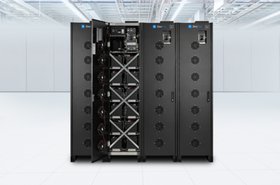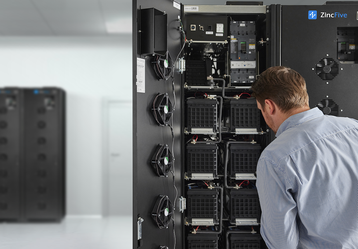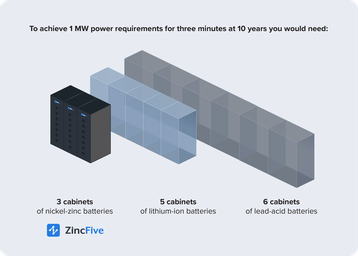In the high-stakes world of data centers, where downtime can spell disaster, the quest for reliable, uninterrupted power is crucial. When utility power goes down, data center Uninterruptible Power Supply (UPS) systems immediately turn to backup batteries to provide power until the generators come online. This ensures business continuity for servers housed at that facility and prevents costly downtime, loss of revenue, and potential damage to the company’s reputation.
Known as “battery backup runtime,” this transitional period has been slashed from 30 minutes to under five minutes within the last decade by advanced generator technologies and power architectures.
Now, many new designs plan to shift their facilities to generator power in three minutes or less. The reduction in battery runtime provides a valuable opportunity for data center owners to optimize their UPS systems for reliability and cost savings.
For instance, many data center UPS systems currently rely on lead-acid batteries – which typically are not optimized for runtimes under five minutes. Re-evaluating the “tried and true” backup battery chemistries can reveal better options with greater reliability and safety during short-term, high-power discharges, a reduced footprint, and lower total cost of ownership.
Harry Handlin, US data center segment leader at ABB says, “Many data centers are selecting runtimes less than five minutes to optimize cost and minimize footprint. These customers have realized long ago that five minutes of UPS battery runtime does not provide added protection. If a generator fails to start, the problem cannot be corrected in five minutes or even 15 minutes.”
Due to their chemistries, traditional lead-acid and lithium-ion batteries require data center owners to purchase more cabinets than ultimately needed to provide adequate short-term power.
In a lead-acid or lithium-ion battery string, a single failed cell impedes the current flow from surrounding cells in the string, creating an increased voltage drop or open circuit that can bring down the entire string in an outage.
Compensating for this weak point requires data center owners to purchase additional redundant battery strings, increasing the overall cost of ownership and taking up valuable real estate within the data center.
In addition, lithium batteries’ risk of thermal runaway requires their Battery Management System (BMS) to disconnect them if even a single battery cell is out of tolerance. While necessary to prevent safety hazards, this precaution can prevent a battery system from providing runtime for the data center.
Newer battery technologies, such as nickel-zinc chemistries, eliminate this need for extra space and costs. Unlike lithium-ion and lead-acid cells, a weak or depleted nickel-zinc cell remains conductive and allows the rest of the battery string to continue delivering power.
Nickel-zinc batteries are also incapable of thermal runaway, so they don’t need to be disconnected in case of a cell failure – allowing them to provide runtime without any concern of the BMS automatically shutting down a battery string. This inherent reliability reduces the need for (and costs of) redundant battery strings.
Nickel-zinc batteries also boast a winning combination for short–term, high-discharge applications: high power density and a high discharge rate. This allows them to reliably provide vast amounts of short-term power in smaller footprints than lead-acid and lithium battery systems.
In contrast, lead-acid batteries have a high discharge rate but relatively low power density, requiring more or larger batteries to handle an equivalent load. Meanwhile, lithium-ion battery cabinets are limited to a low discharge rate, since the BMS shuts them down if their discharge current goes above the level needed to prevent fire hazards. These overcurrent protection limits increase the risk of cutting off the system during use.
Nickel-zinc batteries offer three times the power density of lead-acid, twice the current carrying capability of industry-leading lithium-ion batteries, and a BMS that won’t interrupt runtime operations (since there’s no risk of thermal runaway). This further reduces the cabinets needed and the UPS room’s space requirements, allowing more room within the data center for revenue-generating equipment like servers.
For instance, a three-minute high-power discharge for a 1MW UPS load would only require three cabinets of nickel-zinc batteries, compared to five lithium-ion cabinets and six lead-acid cabinets.
Since nickel-zinc batteries can be optimally sized for runtimes of five minutes or less and offer greater reliability, data center operators only need to buy the minimum number of battery cabinets to support their load and runtime requirements – decreasing their UPS systems’ total cost of ownership.
As data center owners adopt data center designs with faster automatic failover from UPS to generator, they will need a battery that can be right-sized and optimized for shorter runtimes while still delivering a high-power discharge.
When choosing these batteries, they should invest in a battery that provides reliable, safe short-term power bursts in a small footprint with cost-of-ownership savings. With higher power density, reliability, safety, and reduced runtime capabilities, nickel-zinc batteries are a smart and cost-effective choice for the future of data center backup power.
More from ZincFive
-

Sponsored How to achieve sustainable data center backup systems
It’s all about the batteries
-

ABB adds ZincFive nickel-zinc batteries to UPS systems
Says nickel-zinc is a greener alternative to lead-acid and lithium-ion
-

Sponsored “Safe enough” is not safe: Assessing battery tradeoffs in data centers
And why nickel-zinc ensures safety comes first



